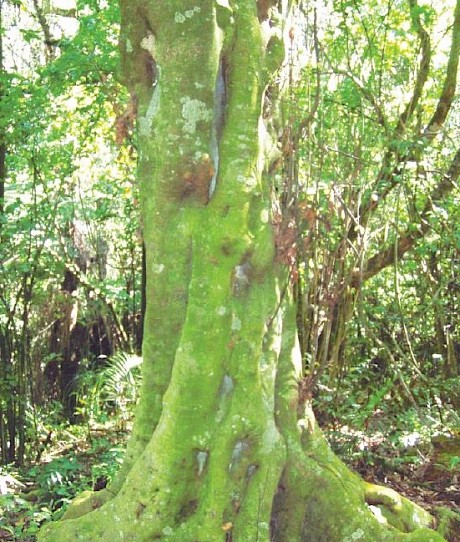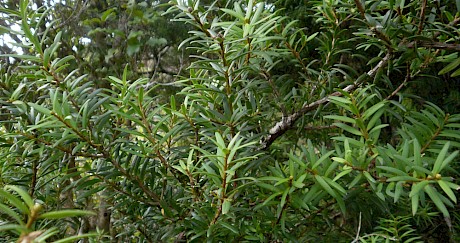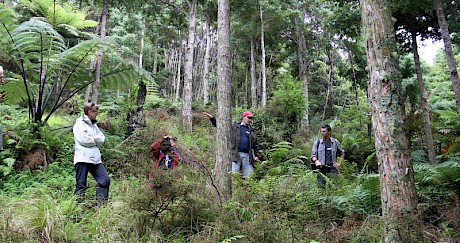Titoki (Alectryon excelsus)
Introduction
Titoki belongs to the family Sapindaceae, most of the members of which are tropical and subtropical in origin. The two New Zealand members of the genera are endemic; the second species, Alectryon grandis, being confined to the cliffs on the northern side of the Great King Island. It is relatively unusual for a New Zealand species in that the aril, a pulpy appendage which partially surrounds the seed, is bright scarlet in colour. This is used to produce a liqueur, developed in the 1980s by the D.S.I.R and used in cocktails and desserts. It is usually available from specialist liquor outlets.
History
Different species of the Sapindaceae are used throughout the Pacific for a wide range of medicinal uses. In the case of titoki the main product is an oil which Maori used to anoint their bodies. This is also beneficial for skin afflictions, painful joints and earache and was taken internally as a laxative. The Maori also used the wood for adze hafts. The timber was used by European settlers where great strength and elasticity was required but it is not durable so when used for items such as bullock yokes, it was essential that they be kept under cover when not in use. Other uses were tool and axe handles, swingle trees, cabinet making and particularly for wheelwright and coach making where strength and bend-ability were important.
Distribution
Titoki is found in lowland forest throughout the North Island, especially on alluvial ground and volcanic loams. In the South Island it grows as far south as Banks Peninsula; further south on the West Coast. Other species in the Genus are confined to Hawaii, several Pacific Islands, New Guinea and Australia.
Tree size and growth
 Photo: H Janssen, Bush Vitality AssessmentRecorded by Allan as normally reaching 10 metres and by Poole and Adams to 17 metres, with diameter usually to 60 cm. A big multi-stemmed tree growing at Otumoetai, Tauranga, has a height of 14 metres and a diameter (at 50 cm) of 2.23 metres. This is an historic tree and was well established in 1845 when the local tribes made peace beneath it after ten years of warfare.
Photo: H Janssen, Bush Vitality AssessmentRecorded by Allan as normally reaching 10 metres and by Poole and Adams to 17 metres, with diameter usually to 60 cm. A big multi-stemmed tree growing at Otumoetai, Tauranga, has a height of 14 metres and a diameter (at 50 cm) of 2.23 metres. This is an historic tree and was well established in 1845 when the local tribes made peace beneath it after ten years of warfare.
Growth rates, from quite small samples taken between Auckland and Palmerston North in the mid 1980s, are consistently between 0.35 and 0.4 metres m.a.i for trees aged between 10 and 38 years. Diameter increment is more variable, between 0.38 and 1.0 cm m.a.i – the mean for trees over 30 being 0.8 cm m.a.i. It is conservatively estimated that reasonably sheltered titoki, growing on good soil, should be able to reach 17 to 19 metres height and 40 cm diameter in 50 years.
Timber
It is difficult to understand why, given the timber qualities and potential for use of titoki, there is no information about timber quality available. The wood is light red in colour and straight grained and hard, with great strength, elasticity and toughness.
Poison potential
Titoki is known to liberate hydrocyanic acid. However there is only one instance where this was suspected of killing animals and that occurred over 60 years ago. The oil of titoki has been investigated and is found to contain cyanolipeds which release hydrogen cyanide. However death or sickness from using the oil as a medicine does not appear to have been recorded.
Research requirements
Research into the various attributes of this native species is well overdue. It appears that the work on the use of the fruit for oil production and liqueur does not appear to have been extended since the 1980s and knowledge of the timber, despite its acknowledged qualities, is non existent. There is presumably considerable scope for the establishment of plantations which can be grown for seed production and timber but, at the same time trials to determine the best method of managing such forests are needed. Suitable sites could be Bay of Islands, circum Pukekohe, Bay of Plenty and any other places which have light soils and adequate rainfall with reasonably high temperatures.
References
Allan H H. 1961. Flora of New Zealand Vol. 1 Government Printer Wellington
Brooker S G, Cambie R C & Cooper R C 1981. New Zealand Medicinal Plants. Heinmann
Brooker S G, Cambie R C & Cooper R C 1988. Economic native plants of NewZealand. Botany Division D.S.I.R
Clifton N C 1990. New Zealand timbers GP Publications
Howard A L 1948. A manual of the timbers of the world. MacMillan & Co, London
Pardy G F, Bergin D O & Kimberley M 1992. Survey of Native tree plantations. FRI Bulletin 175
Poole A L Adams N M 1963. Trees and shrubs of New Zealand. RE Owen, Government Printer
Species profile by Ian Barton


